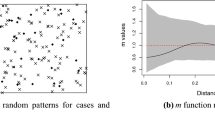Abstract.
Economists have recently devoted an increasing attention to the issue of spatial concentration of economic activities. However, surprisingly enough, most of the empirical work is still based on the computation of very basic statistical measures in which the geographical characteristics of data play no role. By making use of a series of empirical examples we show that spatial concentration consists of two different features that are rarely kept as separate in the statistical analysis: an a-spatial concept of variability which is invariant to permutations, and the concept of polarization that refers to the geographical position of observations.
Similar content being viewed by others
Author information
Authors and Affiliations
Additional information
Received: 8 August 2000 / Accepted: 20 June 2001
Rights and permissions
About this article
Cite this article
Arbia, G. The role of spatial effects in the empirical analysis of regional concentration. J Geograph Syst 3, 271–281 (2001). https://doi.org/10.1007/PL00011480
Issue Date:
DOI: https://doi.org/10.1007/PL00011480




